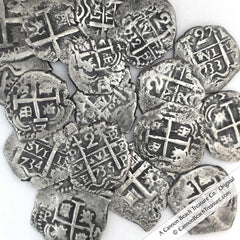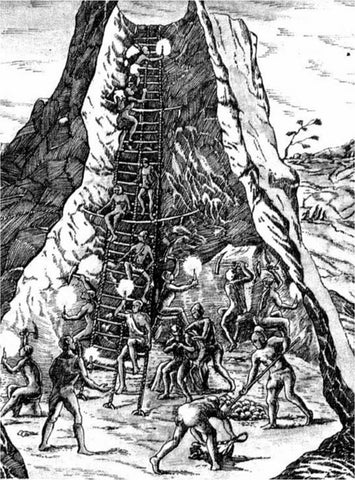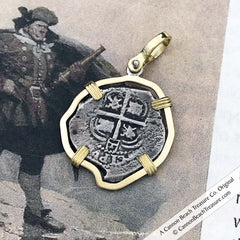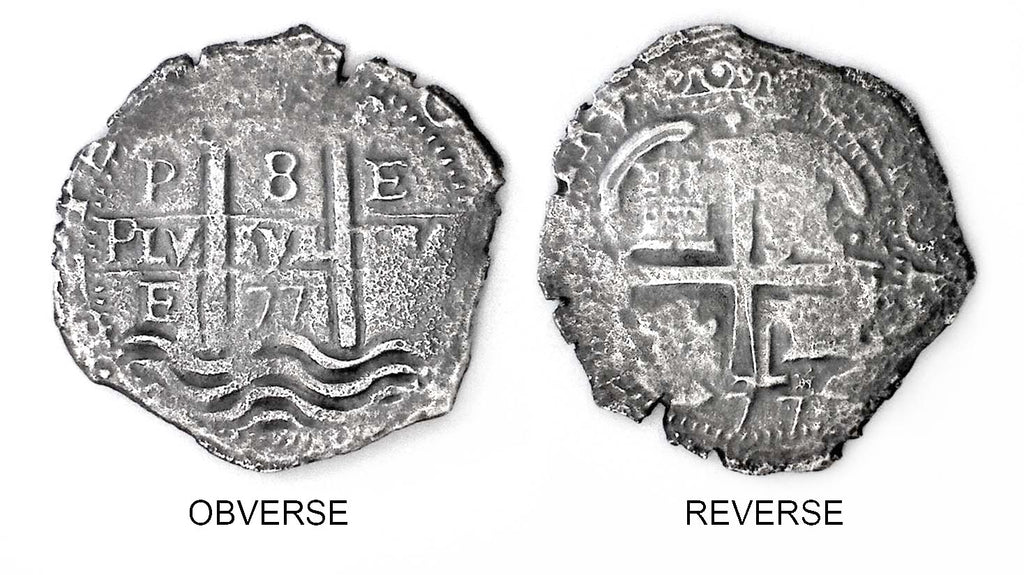How to Read the Legendary Pillars and Waves Coins of the Spanish Main...
 Many of the silver Spanish Reales - or "Pieces of 8" recovered from famous shipwrecks, or found in buried treasure caches, are minted with the Pillars and Waves design. They were struck from 1652 to 1773, and are some of the most detailed and beautiful coins produced in the Spanish colonies, as the design actually tells the story of the Spanish conquest of the “New World.”
Many of the silver Spanish Reales - or "Pieces of 8" recovered from famous shipwrecks, or found in buried treasure caches, are minted with the Pillars and Waves design. They were struck from 1652 to 1773, and are some of the most detailed and beautiful coins produced in the Spanish colonies, as the design actually tells the story of the Spanish conquest of the “New World.”
But to understand the meaning behind thier design, and how to read them, it is helpful to take a brief trip back in time... Inspired by Cortés’ success in “conquering” Mexico, Francisco Pizarro González made several attempts to conquer Peru (including what is present-day Bolivia). He finally succeeded in 1533. In 1545, at over 15,000 feet above sea level, a mountain of silver was discovered. Some of the
Inspired by Cortés’ success in “conquering” Mexico, Francisco Pizarro González made several attempts to conquer Peru (including what is present-day Bolivia). He finally succeeded in 1533. In 1545, at over 15,000 feet above sea level, a mountain of silver was discovered. Some of the
veins contained as much as 50 percent pure silver. They called it Cerro de Potosí - some called it Cerro Rico (“rich hill”).
In 1573, the first silver coins were minted in Potosí, Upper Peru (present-day Bolivia). For the next 250 years they were loaded on mules and llamas to begin the arduous two week, 120 mile trek down the mountain to Arica (now in modern day Chile), where they were loaded on a small fleet of Spanish galleons (three or four) and other vessels that would sail north to Callao, the port at Lima. At Callao, they would pick up more gold and silver from the Lima mine and mint. The South Seas Fleet then began the 1,300-mile voyage to Panama. There the treasure would be carried across the isthmus (the same place the Panama Canal runs through today), then loaded on other galleons that were headed to Havana, Cuba. In Havana Harbor, more galleons joined them from Mexico and other Caribbean ports, and together they headed north to Spain.
At Callao, they would pick up more gold and silver from the Lima mine and mint. The South Seas Fleet then began the 1,300-mile voyage to Panama. There the treasure would be carried across the isthmus (the same place the Panama Canal runs through today), then loaded on other galleons that were headed to Havana, Cuba. In Havana Harbor, more galleons joined them from Mexico and other Caribbean ports, and together they headed north to Spain.
Once they reached Spain, several things could happen to the coins: 1. sometimes the king “commandeered” them to pay for wars and other debts Spain incurred; 2. they were melted down and re-minted in Spanish mints; 3. they were melted and made into silver plate, like religious items, tableware or jewelry; 4. they were used in trade, and that is how Spanish New World coins, minted in South and Central America, wound up quite literally, all over the world! In ancient times, legend says that Hercules created the Pillars of Hercules (that flank the entrance to the Strait of Gibraltar) to prevent sea monsters from entering the Mediterranean from the Atlantic. The Latin phrase “NEC PLVS VLTRA” (No More Beyond) was used to describe what lay beyond the Pillars in the Atlantic Ocean, as some believed that if you sailed far enough you would fall off the edge of the Earth. The Pillar in the north is the Rock of Gibraltar, in Gibraltar (a British territory) on the southern tip of the Iberian Peninsula, and in the south either Monte Hacho or Jebel Musa in North Africa.
In ancient times, legend says that Hercules created the Pillars of Hercules (that flank the entrance to the Strait of Gibraltar) to prevent sea monsters from entering the Mediterranean from the Atlantic. The Latin phrase “NEC PLVS VLTRA” (No More Beyond) was used to describe what lay beyond the Pillars in the Atlantic Ocean, as some believed that if you sailed far enough you would fall off the edge of the Earth. The Pillar in the north is the Rock of Gibraltar, in Gibraltar (a British territory) on the southern tip of the Iberian Peninsula, and in the south either Monte Hacho or Jebel Musa in North Africa.
In the early 1500s, the job of organizing the Spanish Treasure Fleets coming over from the newly discovered New World mines fell to Charles I of Spain (Charles V of the Holy Roman Empire). And since the Spanish fleets sailed from the Strait of Gibraltar, his motto became “Plus Ultra,” or “More Beyond,” which today is still Spain’s national motto.
The beautiful Pillars and Waves design described below began being used when Potosi mint assayer Antonio de Elqueta was tasked with redesigning the Potosi and Lima mint coins after the Great Potosi Mint Scandal (to be discussed in a future blog post). But a similar design was used on the first coins stuck at the Mexico City mint starting in the mid 1500s.
To see the Princess Louisa British East India Company shipwreck Pieces of Eight, click here>>>
 The 8 real example here is from the Spanish galleon, Consolacion, which sank in 1681 off Ecuador. It is the same design as many of the coins recovered from Princess Louisa.
The 8 real example here is from the Spanish galleon, Consolacion, which sank in 1681 off Ecuador. It is the same design as many of the coins recovered from Princess Louisa.
- Note the tick-tack-toe design. The two upright “pillars” represent the Pillars of Hercules; the waves below, the Atlantic Ocean. Starting in the 10 o’clock position there is a “P” for Potosi, next is the 8 for the denomination of “8 reale” (pronounced ray-al).
- Next is the assayer’s initial “E” for Antonio de Elqueta, who ran the mint from 1651 to 1679. The other “E” means the same.
- The numerals “77” (meaning 1677) are visible between the Pillars at the crest of the wave.
- Through the center runs the phrase PLV SVL TRA – “Plus Ultra” – More Beyond the Pillars of Hercules.
- On the reverse is the Jerusalem cross, with lions and castles in the four quadrants representing the early Spanish kingdoms of Leon and Castile.
- At the bottom of the cross is also “77.” Coins minted in the 1700s will have three digits, i.e. 737 for 1737. While not always visible, a four digit date can be found on the edge of the coin off the lower left “E” and waves.
Historical mint fact: only a small percent (educated guess would be less than 5%) of the “cob” type coins minted at the Mexico City mint had visible dates. The planchets were so crudely shaped, and the dates were on the outer edges of the dies, most of the time that part of the design “fell off” the planchet and was never visible. However, Potosi and Lima minted coins from 1652 to 1773 had three dates, and usually at least one was visible, the date between the Pillars. A double-dated coin is rarer, and being able to see three dates makes the coin extremely rare.
Interesting fact: If you see an “L” in place of the “P” on your coin, note that the waves will also be pointing down under the date, instead of up as shown in the photo above. This means the coin was minted in Lima, Peru, as Potosi is high in the mountains, but Lima is down on Peru’s coast. But to add more confusion, if "P" is in the place of the "L" but the waves are still pointing down, it is still the Lima, Peru mint, but just a die design before they changed that letter to "L" for Lima.
To view our entire collection of shipwreck and buried Spanish treasure coins, click here>>>
© Cannon Beach Treasure Company - Robert Lewis Knecht
Copying any part of this document in any form is a violation of U.S. copyright law. CBTC strictly enforces any violations.




1 comment
I generally do not leave comments but wanted to say how informative your site is. I have been diving and detecting for over 50 years and stay on the quiet side. This week is identifying cobs found recently and I found your site very informative. I will keep it in mind if I ever want to sell some cobs and coins. Thank You and have a great day.